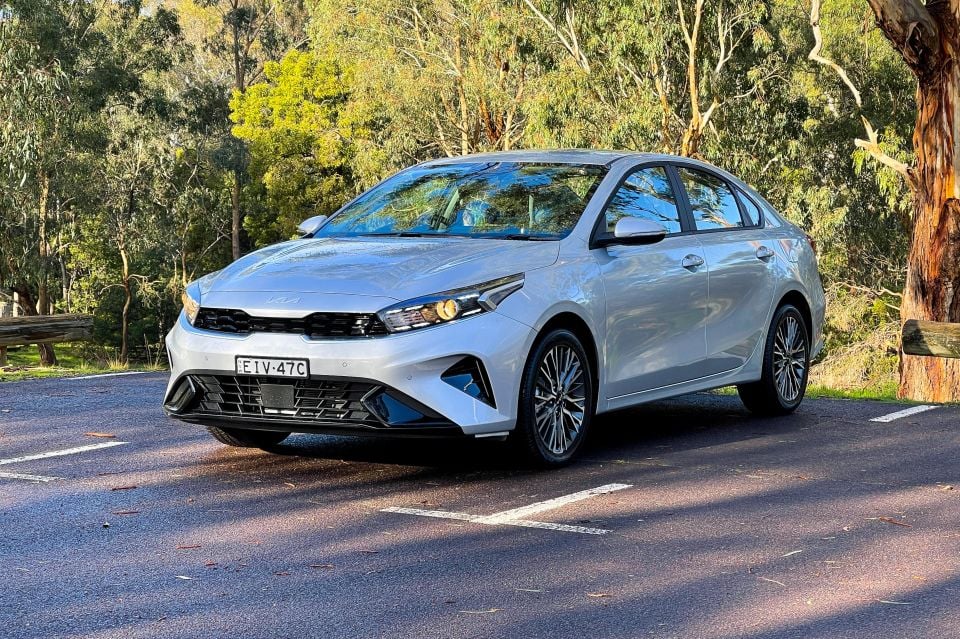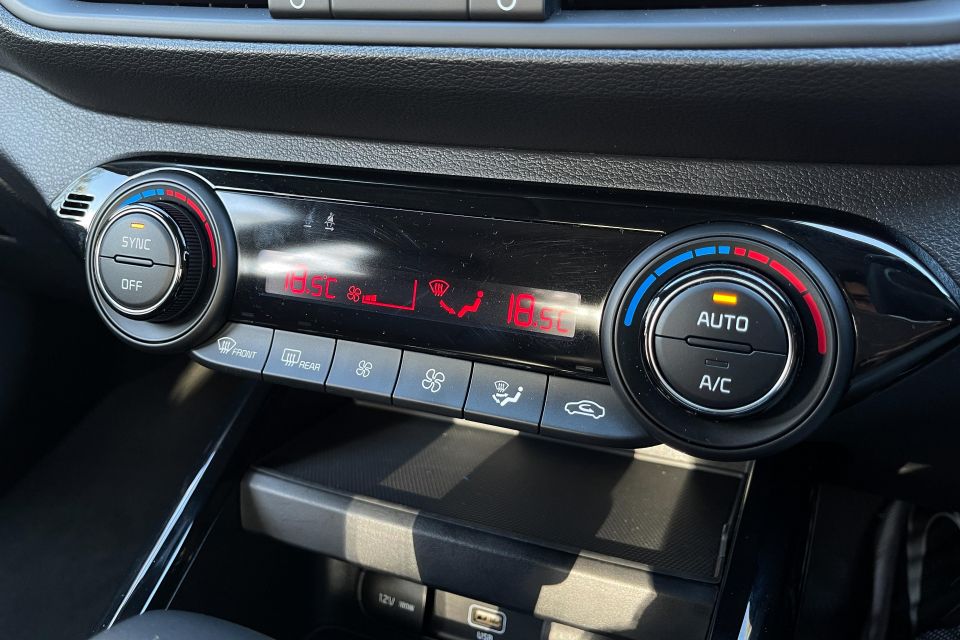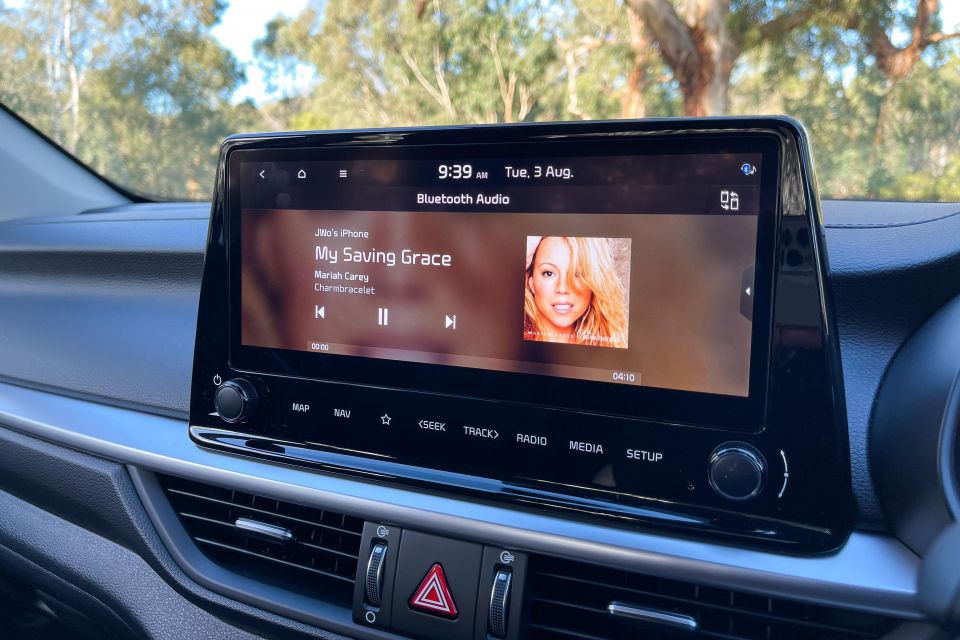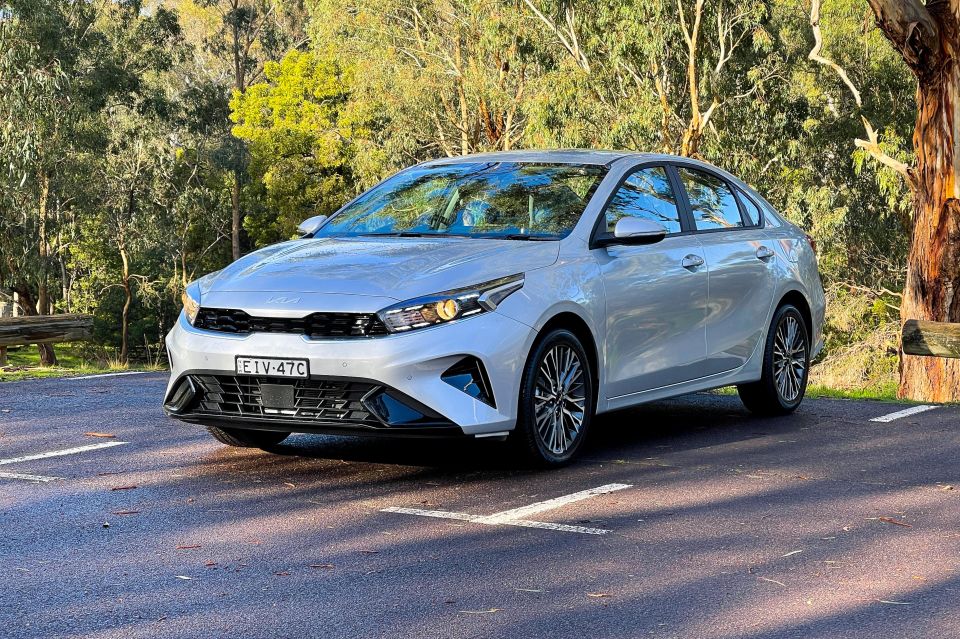

Max Davies
2026 Ram 1500 Rebel review
5 Days Ago
The top dog in the Cerato's non-performance line-up stays true to its roots but is merely average in a rapidly-developing segment.



Marketplace Editor
New from
$21,490
excl. on-roads

Marketplace Editor
New from
$21,490
excl. on-roads


Marketplace Editor
New from
$21,490
excl. on-roads

Marketplace Editor
New from
$21,490
excl. on-roads
Quickly see how this car stacks up against its competition. Select any benchmark to see more details.
Where expert car reviews meet expert car buying – CarExpert gives you trusted advice, personalised service and real savings on your next new car.
The Kia Cerato has long been a value option in the small passenger segment, with sharp drive-away pricing, strong equipment levels, and a no-nonsense approach to everyday motoring.
It’s become a hit with private buyers and fleets alike, and was recently treated to a mid-life refresh, also debuting Kia’s new logo in Australia.
While the world around it has changed since this generation launched in 2018, the Cerato hasn’t really seen big changes aside from pricing, which has jumped quite a bit over the past few years.
Can the refreshed 2022 Kia Cerato Sport+ (sampled here in sedan guise), justify its $5500 price climb over the past three years? Let’s find out.

The 2022 Cerato Sport+ is currently offered from $31,690 drive-away regardless of whether you choose the hatchback or sedan.
Our tester’s Silky Silver premium paint adds a further $520.
See the full 2022 Kia Cerato price list below:
All prices are drive-away

While it’s fairly sharp pricing for a near-top-spec small car, Cerato pricing has risen some $3000-5000 depending on variant since this generation went on sale in 2018. I tested a Sport+ sedan not long after the launch and at the time you could buy one for $26,190 drive-away.
Even if you factor the facelift, there’s very little in the way of major upgrades across the line-up in terms of equipment and tech.
Key rivals at this price point include:
All prices are before on-road costs unless specified

Buy your new car without the stress. It's fast, simple and completely free.

Great service from Travis and team, second time I have used this business would not hesitate to recommend them to anyone
Craig C.
Purchased a Ford Ranger in Sunshine Coast, QLD
CarExpert helped Craig save $7,224 on his Ford Ranger, now let us save you on your next new car.
Get your BEST priceThe Cerato Sport+ picks up the following equipment over lower grades:
That’s on top of carryover specification including:

Overall the top-spec variant in the core Cerato line-up doesn’t want for too much, but there’s still items missing that are either not offered at all or at least available in its home market of South Korea.
LED (reflector-type) headlights and tail lights are reserved for the GT, which seems stingy when Mazda and Volkswagen offer this for similar money. The 10.25-inch digital instrument cluster available in the Korean-market K3 also is absent locally in any variant.
Some will lament the lack of a sunroof in Sport+ guise, along with the absence of automatic windscreen wipers (c’mon Kia, seriously?!). There’s also no alternative leather colour choices like the brown offered in Kia’s home market.
Considering the marked increase in pricing since this generation launched, you could feel a little short-changed when rivals offer similar or better levels of standard kit at the price.

When the Kia Cerato was tested by ANCAP in 2019, it received a split rating.
Kia Cerato S and Sport models without the Safety Pack received a rating of four stars, while all other Cerato models received a rating of five stars from ANCAP.
Models without the Safety Pack received an adult occupant protection score of 90 per cent, child occupant protection score of 83 per cent, vulnerable road user protection score of 55 per cent and a safety assist score of 71 per cent.
The S and Sport with Safety Pack variants, as well as the Sport+ and GT officially get enhanced vulnerable road user (72 per cent) and safety assist (73 per cent) scores.

All 2021 Kia Cerato models come standard with the following safety equipment:
When equipped with the Safety Pack, or in Sport+ and GT trim, the list of safety equipment is expanded to include:
The Sport+ and GT also feature blind-spot assist.

There’s a sense of familiarity when you hop in the driver’s seat of the Cerato, because the layout has largely been untouched.
Yes there’s a new, larger touchscreen in higher grades and the steering wheel hub now wears Kia’s latest logo, but everything else is pretty much the same.
An updated TFT display in the driver’s instrument cluster feels a little higher end than the old model, and the new standard electric park brake neatens up the centre console a bit too.




This means the Cerato’s core strengths remain. It’s a clean and uncluttered cockpit that’s well-finished in the places that matter and the ergonomics are sound. Likewise, the front seats are comfortable and offer a decent range of (manual) adjustment.
Soft-touch materials adorn the dash and door tops, with a mix of gloss black, satin silver, and textured plastics scattered lower down. Build quality feels solid as it always has, and the switchgear is all nicely damped and doesn’t feel cheap or flimsy in operation.
The ‘premium’ leather-look steering wheel and gearshift trim is smooth and supple, and the leather-appointed seat trim is nice enough and features an interesting diamond perforation pattern.


As we’ve noted in other reviews of the latest Hyundai/Kia models, the new 10.25-inch infotainment system is one of the best in the business. The high-definition widescreen, quick response times and attractive interface are all winners. In what is still a budget-conscious economy vehicle, it lifts the certainly ambience.
Wired Apple CarPlay and Android Auto are commonplace these days, and we’d argue the reliability of a wired connection outweighs the slickness of the occasionally problematic wireless connection in the base S, though Hyundai and Kia seem to have ironed out kinks with the latter of late.
Space and storage is good up front, with a large two-shelf cubby under the centre stack for your phone, keys and wallet, while there’s decent-sized door pockets as well as a cubby under the front-centre armrest.


In the second row it’s more of the same, with rear air vents (now standard across the range for 2022), a USB-A charge port, a map pocket behind the front passenger seat, and a fold-down centre armrest with cupholders.
Head- and legroom is good without being excellent, with the sloping roofline a potential issue for taller passengers.
At 6’1-ish I can sit behind my own driving position in decent comfort, so shorter adults and kids will be easily catered for. The large rear windows mean car sickness-prone passengers are better off than they would be in the back of the rakish Mazda 3 hatchback, for example.

ISOFIX points on the outer rear seats feature for the littlest of kiddies, and there’s top-tether points across all three rear positions.
Under the bootlid is a big 502L (VDA) boot area that’s well ahead of hatchback equivalents in the class, including the Cerato Hatch (428L). The rear seats fold 60:40 and there’s a space-saver spare under the boot floor.

All non-GT versions of the Kia Cerato are powered by a carryover 2.0-litre ‘MPi’ four-cylinder naturally-aspirated petrol engine. Australian models miss out on the latest ‘Smartstream’ engines offered abroad which are claimed to be more efficient.
Quoted outputs are 112kW (6200rpm) and 192Nm (4000rpm), with drive sent to the front wheels via a six-speed conventional automatic. It’s worth noting this engine has been in service since around 2016 in the previous-generation Cerato, with outputs unchanged.
Fuel use is a claimed 7.4L/100km on the combined cycle, with 91 RON regular unleaded the minimum octane rating for its 50L fuel tank.

Where expert car reviews meet expert car buying – CarExpert gives you trusted advice, personalised service and real savings on your next new car.
While the engine’s specifications are fine on paper, rivals for similar money offer similar or stronger outputs, or more resolved real-world performance.
The best point of reference would be the Hyundai i30 Sedan, which is on the next-generation Hyundai/Kia small car platform, and gets a newer engine with more power and better efficiency.
In Active spec, the i30 Sedan’s 2.0-litre four develops 117kW (6200rpm) and 191Nm (4500rpm), while claiming to use 7.0L/100km. Plus, the new platform is some 50kg lighter.

It’s been a while since I’ve driven a Cerato, but it’s a mixed bag given the Kia hasn’t changed much and the segment has moved on significantly.
The 2.0-litre ‘MPi’ atmo petrol was barely ‘adequate’ when the current generation launched, and against the current crop of rivals it feels old-hat while also lacking in grunt and refinement.
Keep your demands gentle and it’s well-mannered enough, but push any harder and it’s a noisy and gruff engine over 3000rpm.
It feels like the Cerato gets off the line well enough, but try to get up to 100km/h on the freeway on-ramp or go up a steep hill and it’s just unrefined and laboured. A lot of noise – not a nice note either – and not a whole lot of performance.

Why Kia has persisted with such an ageing drivetrain format for any reason other than cost remains to be answered. Even swapping out the (admittedly snappy) six-speed auto for the continuously-variable transmission from the related Seltos would have been a better move – North America gets this setup too.
Beyond the lacklustre drivetrain, the rest of the Cerato’s on-road behaviour is pretty good.
Its locally-fettled suspension tune – with torsion-beam rear in non-GT models – errs on the side of firm, but it’s comfortable enough in town and settles well on the highway.
The steering, likewise, is tuned to be a direct and engaging. The Cerato has a lively feel to the ride and handling, though in most variants lacks the drivetrain to back it up.
Road noise is a little intrusive on rougher patches of blacktop, but it’s definitely not the worst in the class. Wind noise, meanwhile, is well suppressed.

Kia’s latest driver assists are generally pretty good, with the standard lane-keep assist not feeling too intrusive and the adaptive cruise control being a handy addition for long stints on the freeway.
I personally like the Lane Following Assist active centring function for the open road, though some may not like how it takes charge.
The Cerato’s adaptive cruise system has been improved from my experience with the previous model, but it still will drift 2-3km/h above or below the set speed on hills and when you let off the throttle if you take over for a moment – it’s certainly not as accurate as rival systems.
Overall, the Kia Cerato remains a solid, if uninspiring package on the road.

The Cerato is covered by Kia’s seven-year, unlimited kilometre warranty.
Maintenance is required every 12 months or 15,000km in 2.0-litre Cerato models, and there’s capped-price servicing for up to seven years or 105,000km.
Those seven visits cost $275, $469, $339, $623, $309, $596 and $328, totalling $2939 for the life of the program.
Over the first five years, the Cerato will set you back $2015 in scheduled maintenance, which is still on the higher side of the segment.
For example, a Toyota Corolla costs $205 a pop for the first five years, making it almost half the cost of the Kia.
As for real-world fuel consumption, we managed an indicated 8.1L/100km over our week of testing with a mix of freeway and peak-hour city traffic. You can expect 550-600km per fill of the 50L, and as noted earlier it runs happily on 91 RON unleaded.

Buy your new car without the stress. It's fast, simple and completely free.

Great service from Travis and team, second time I have used this business would not hesitate to recommend them to anyone
Craig C.
Purchased a Ford Ranger in Sunshine Coast, QLD
CarExpert helped Craig save $7,224 on his Ford Ranger, now let us save you on your next new car.
Get your BEST priceThe Cerato’s mild mid-life refresh has put a new glossy coat on what was an already solid offering, though the competition has upped its game and Kia has upped its prices.
For between $32,000 and $35,000 there’s a lot of capable metal you can buy, from the more premium-feeling Mazda 3 Sedan and uber-practical Skoda Scala, to the sporty Ford Focus ST-Line and cheap-to-run Corolla Sedan.
Even within the Hyundai/Kia stable, the similarly-packaged i30 Sedan offers newer underpinnings and running gear, as well as a more eye-catching design. There’s a lot of good choices at this end of the market.
The Cerato impresses with a capable chassis, strong equipment inclusions and big-car space, though is let down by its increasing price and lacklustre motor.
Our advice is to either spend up and grab the GT – which is arguably one of the best-value warm hatches/sedans under $40,000 – or drop down a rung and get the Cerato Sport with Safety Pack which comes in at $2200 cheaper while retaining the great infotainment system and the bulk of features you really want.

Click the images for the full gallery
MORE: Everything Kia Cerato
Where expert car reviews meet expert car buying – CarExpert gives you trusted advice, personalised service and real savings on your next new car.
James is an automotive journalist based in Melbourne, Australia. Before joining CarExpert.com.au in 2020, James has worked at leading auto media outlets including Carsales and CarAdvice, as well as at Pulse agency for Ford Australia's communications team. In 2019 James made Mumbrella's 'Top 20 most prolific web authors in Australia' list after publishing 1,360 articles between March 1, 2018 and February 28, 2019 for CarAdvice. James is also an Ambassador for Drive Against Depression – an Australian charity whose mission is to support mental wellness through the freedom of driving and a shared love of cars.


Max Davies
5 Days Ago


Max Davies
4 Days Ago


Neil Briscoe
3 Days Ago


Max Davies
2 Days Ago


Alborz Fallah
9 Hours Ago


Damion Smy
9 Hours Ago